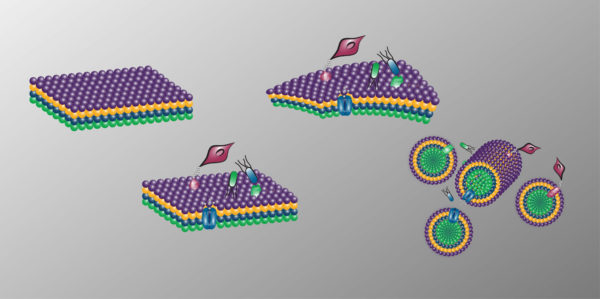Improving computational models of RNA dynamics that can incorporate experimental data.
Bottleneck/Challenge: There is a lack of rigorous physical models that can incorporate experimental characterization of RNA structure and physicochemical data into models of RNA folding dynamics.
Potential Solution: Expansion of RNA folding dynamics physicochemical modeling toolsets to incorporate experimental data.
Potential Solution: Machine-learning based models of RNA structure based off large-scale experimental characterization datasets.
Incorporating co-transcriptional (for RNA) and co-translational (for protein) processes (and including cellular factors that participate in these processes) into design algorithms.
Bottleneck/Challenge: A lack of principles of co-transcriptional RNA folding and co-translational protein folding that can be incorporated into design algorithms.
Potential Solution: Approaches to use model systems along with a variety of techniques (high-throughput chemical biology, biophysical) to uncover the required principles.
Bottleneck/Challenge: No RNA or protein design algorithms incorporate co-transcriptional or co-translational folding dynamics into the design process.
Potential Solution: Incorporate the design principles learned from the study of these processes into these algorithms.
Potential Solution: Develop appropriately coarse-grained models that can efficiently simulate co-transcriptional and co-translational folding.
Design of intrinsic regulatory control into biomolecules (e.g., allostery).
Bottleneck/Challenge: Long-range interactions in proteins are difficult to capture in computational protocols because of the enormous amount of conformational sampling that would be required, propagation of error, and limitations in scorefunction accuracy over long ranges.
Potential Solution: A focus on short-range allosteric interactions may be necessary; statistical approaches to understanding long-range allosteric interactions will be useful for future regulatory design.
Bottleneck/Challenge: We lack a sufficient understanding of how ligand-, protein-, and RNA-RNA binding can dynamically alter RNA structure in either equilibrium or out-of-equilibrium RNA folding regimes.
Potential Solution: Development and validation of approaches that can map RNA-ligand and protein- and RNA-RNA interactions at atomic resolution and in high-throughput.
Potential Solution: Development and validation of approaches that can extract RNA folding sub-population information to uncover principles of ligand-, protein-, and RNA-RNA mediated conformational changes.
Bottleneck/Challenge: There are few RNA aptamers that can sense ligands with Kd’s that are sub-micromolar, required for many applications.
Potential Solution: Expansion into non-natural nucleic acid chemistries to expand the structure and chemical diversity of aptamers.
Design of dynamic and responsive protein-RNA nanomachines.
Bottleneck/Challenge: It is challenging to image the three-dimensional structure of self-assembled protein-RNA nanostructures within the cell.
Potential Solution: Application of high-resolution techniques (super-resolution imaging, cryo-EM) to model synthetic protein-RNA nanostructures.
Potential Solution: Use of high-throughput techniques (in-cell chemical probing) to validate proper cellular assembly.
Bottleneck/Challenge: Primitives for converting molecular binding (e.g. ligands, RNAs) into changes in a three-dimensional protein-RNA nanostructure are underdeveloped.
Potential Solution: Incorporate known natural motifs that allow ligand and RNA-mediated switching into protein-RNA nanostructures.
Bottleneck/Challenge: RNA-protein interactions required for nanomachines with most sophisticated functions (e.g., dynamic control over protein complexes, cell signaling pathways) are challenging to engineer.
Potential Solution: Harness improved tools for predicting RNA-protein interactions and integrate them into design of dynamic RNA nanomachines.
Routine design of large proteins, beta topologies, membrane proteins, and loops.
Bottleneck/Challenge: Although these challenges have recently been addressed, the computational methods are too nascent to ensure that successful design is achieved routinely.
Potential Solution: Continued exploration of these computational methods will begin to elucidate the potential for success and existing limitations.
Bottleneck/Challenge: Designing functional proteins requires successful prediction of not just the topology, but also the precise positioning of the elements within that topology.
Potential Solution: Explore new approaches to designing specific conformations within an existing topology that satisfy user-specified parameters, such as angles between secondary structure elements.
Routine design of protein complexes.
Bottleneck/Challenge: Predicting and modelling protein-protein interactions is difficult.
Potential Solution: Continued development of co-evolutionary models, physics models, and design platforms.
Bottleneck/Challenge: Stronger influence of environment: in contrast to the design of individual proteins, complexes require molecules to assemble in a sea of other molecules.
Potential Solution: Improved molecular dynamics simulations.
Routine design of enzymes with high activities (i.e., kcat/KM > 105 1/M*s).
Bottleneck/Challenge: Most powerful protein design platforms don’t address molecular dynamics well, and protein dynamics are fundamentally challenging to capture.
Potential Solution: Ability to at-will engineer enzyme specificity, including to understand what enzymes exist, understand principles behind what exists, and map domain and sequence/functions.
Potential Solution: Improve multi-state design algorithms which are aimed at designing proteins with multiple interchanging conformations.
Bottleneck/Challenge: Successful catalysis often requires considerations other than conformation and residue positioning, such as active site electrostatics.
Potential Solution: Explore the use of more accurate but computationally expensive simulations, such as quantum mechanical calculations, to determine the optimal electrostatic environment for a desired reaction; couple this knowledge with constraints on active site electrostatics during the design process. Alternatively, use knowledge from existing enzymes that catalyze similar reactions to guide these constraints.
Modeling and design of dynamic RNA nanomachines that can engage with and manipulate the chromatin states of living systems.
Bottleneck/Challenge: De novo understanding of RNA structure-function relationship is currently beyond reach and measuring manipulations of chromatin states in complex living systems adds an additional layer of uncertainty.
Modeling and design of dynamic DNA-RNA-protein condensates that can expand beyond the functionality of natural condensates.
For example, heterochromatin, mediator, and Pol II nuclear condensates that govern transcription initiation.
Bottleneck/Challenge: Robust, physics-based models of condensate interactions that can be extrapolated to predict unknown functionality.
